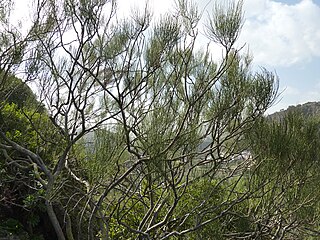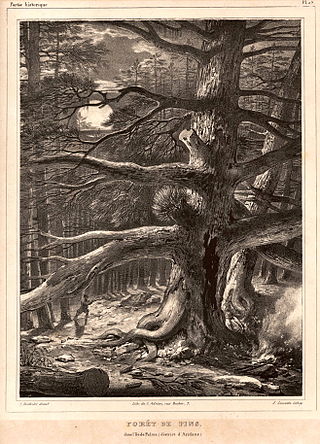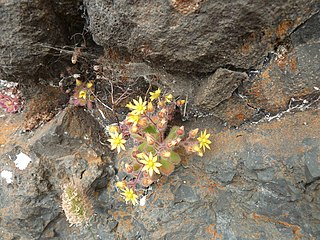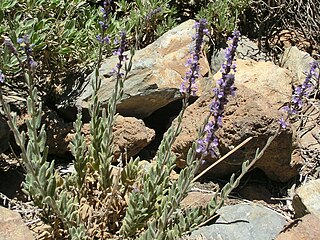
Genista is a genus of flowering plants in the legume family Fabaceae, native to open habitats such as moorland and pasture in Europe and western Asia. They include species commonly called broom, though the term may also refer to other genera, including Cytisus and Chamaecytisus. Brooms in other genera are sometimes considered synonymous with Genista: Echinospartum, Retama, Spartium, Stauracanthus, and Ulex.

Retama is a genus of flowering bushes in the legume family, Fabaceae. It belongs to the broom tribe, Genisteae. Retama broom bushes are found natively in North Africa, the Levant and some parts of southern Europe. Retama raetam and Retama monosperma have white flowers, while Retama sphaerocarpa has yellow flowers. It remains an open question in taxonomy whether the members of the genus Retama should be incorporated into the genus Genista.

Aeonium, the tree houseleeks, is a genus of about 35 species of succulent, subtropical plants of the family Crassulaceae. Many species are popular in horticulture. The genus name comes from the ancient Greek αἰώνιος / aiōnios (ageless). While most of them are native to the Canary Islands, some are found in Madeira, Cape Verde, Morocco, in East Africa and Yemen.

Philip Barker Webb was an English botanist.

Sabin Berthelot was a French naturalist and ethnologist. He was a resident of the Canary Islands for part of his life, and co-authored L'Histoire Naturelle des Îles Canaries (1835–50) with Philip Barker Webb.

Christian Horace Benedict Alfred Moquin-Tandon was a French naturalist and doctor.

Lotus, a latinization of Greek lōtos, is a genus of flowering plants that includes most bird's-foot trefoils and deervetches and contains many dozens of species distributed in the eastern hemisphere, including Africa, Europe, western, southern, and eastern Asia, and Australia and New Guinea. Depending on the taxonomic authority, roughly between 70 and 150 are accepted. Lotus is a genus of legumes and its members are adapted to a wide range of habitats, from coastal environments to high elevations.

Argyranthemum is a genus of flowering plants belonging to the family Asteraceae. Members of this genus are sometimes also placed in the genus Chrysanthemum.

Micromeria is a genus of flowering plants in the mint family, Lamiaceae, widespread across Europe, Asia, Africa, and North America, with a center of diversity in the Mediterranean region and the Canary Islands. It is sometimes placed within the genus Satureja. The name is derived from the Greek words μῑκρος (mīkros), meaning "small," and μερίς (meris), meaning "portion," referring to the leaves and flowers. Common names include savory and whitweed.

Malva arborea, the tree mallow, is a species of mallow native to the coasts of western Europe and the Mediterranean region, from Ireland and Britain south to Algeria and Libya, and east to Greece.

Echium pininana, commonly known as the tree echium, pine echium, giant viper's-bugloss, or tower of jewels, is a species of flowering plant in the borage family Boraginaceae. It is endemic to the Canary Islands, where it is restricted to the island of La Palma. Echium pininana is an endangered species, and is listed in Appendix I to, and is therefore protected under, the Convention on the Conservation of European Wildlife and Natural Habitats. The specific epithet pininana is Latin for "small pine", though E. pininana is neither closely related to the pine, nor does it resemble that plant.

Bystropogon is a genus of evergreen shrubs in the family Lamiaceae. It is native to the Canary Islands and Madeira in the eastern Atlantic Ocean. Allied to the Origanum and Thymus, the genus is characterized by tiny flowers in much-branched clusters, with plume-like sepals that elongate at the fruiting stage, giving the whole tip of each branch a fuzzy appearance. Stems are square in cross-section and leaves, arranged in opposite pairs, are aromatic when crushed.

Clethra arborea, commonly known as the lily-of-the-valley-tree, is a flowering plant in the genus Clethra. It is found in Macaronesia where it is native to Madeira, extinct in the Canary Islands, and considered an introduced species in the Azores. In Madeira its natural habitat is laurisilva forest.

Retama rhodorhizoides is a species or subspecies of flowering plant in the family Fabaceae, endemic to the Canary Islands.

Aeonium balsamiferum is a species of tropical flowering plant in the family Crassulaceae. The species is endemic in the Canary Islands.

Natural History of the Canary Islands is an illustrated reference work of the natural history of the Canary Islands. It was written by the English botanist Philip Barker-Webb and the French naturalist and ethnologist Sabin Berthelot, in cooperation with several other scientists. It was published in Paris between 1836 and 1850. The work is considered the most important 19th century text about the Canary Islands in the field of natural sciences.

Aichryson villosum is a species of herbaceous flowering plants in the family Crassulaceae endemic to the Madeira Archipelago. The species was first described by Sabin Berthelot and Philip Barker-Webb in 1840, published in Natural History of the Canary Islands. Aichryson santamariensis was previously included in this species, but is now considered a different species endemic to Santa Maria Island, Azores.

Erysimum scoparium is a species of flowering plant in the family Brassicaceae, native to the Canary Islands. It is a shrubby species of wallflower with purplish flowers found at high altitudes.

Lavandula buchii is a species of flowering plant in the family Lamiaceae, endemic to Tenerife in the Canary Islands. It was first described by Philip Barker-Webb and Sabin Berthelot, in a part of an 1844–1850 publication that has been dated to 1844.

Nepeta teydea is a species of flowering plant in the family Lamiaceae, native to the Canary Islands. It was first described by Philip Barker-Webb and Sabin Berthelot.






















